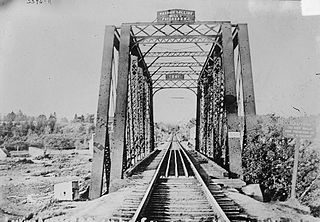
Mattawamkeag is a town in Penobscot County, Maine, United States, located where the Mattawamkeag River joins the Penobscot River. The population was 687 at the 2010 census.

Vanceboro is a town in Washington County, Maine, United States. The town was named after landowner William Vance. The town is located at the eastern terminus of Maine State Route 6. Vanceboro is across the St. Croix River from St. Croix, New Brunswick, Canada, to which it is connected by the Saint Croix – Vanceboro Bridge. The crossing has a 24-hour customs station managing the border. Vanceboro is also connected to St. Croix by the Saint Croix-Vanceboro Railway Bridge which is used by the New Brunswick Southern Railway.

The St. Croix River is a river in northeastern North America, 71 miles (114 km) in length, that forms part of the Canada–United States border between Maine (U.S.) and New Brunswick (Canada). The river rises in the Chiputneticook Lakes and flows south and southeast, between Calais and St. Stephen. It discharges into Passamaquoddy Bay, in the Bay of Fundy.

The Maine Central Railroad Company was a former U. S. Class I railroad in central and southern Maine. It was chartered in 1856 and began operations in 1862. By 1884, Maine Central was the longest railroad in New England. Maine Central had expanded to 1,358 miles (2,185 km) when the United States Railroad Administration assumed control in 1917. The main line extended from South Portland, Maine, east to the Canada–United States border with New Brunswick, and a Mountain Division extended west from Portland to Vermont and north into Quebec. The main line was double track from South Portland to Royal Junction, where it split into a "lower road" through Brunswick and Augusta and a "back road" through Lewiston which converged at Waterville into single track to Bangor and points east. Branch lines served the industrial center of Rumford, a resort hotel on Moosehead Lake, and coastal communities from Bath to Eastport.
The New Brunswick Railway Company Limited (NBR) is currently a Canadian non-operating railway and land holding company headquartered in Saint John, New Brunswick that is part of "Irving Transportation Services", a division within the J.D. Irving Limited (JDI) industrial conglomerate. It is not to be confused with another JDI company, New Brunswick Southern Railway (NBSR), established in 1995, which is an operational railway and considered a sister company of the NBR.

The International Railway of Maine was a historic railroad constructed by the Canadian Pacific Railway (CPR) between Lac-Mégantic, Quebec, and Mattawamkeag, Maine, closing a key gap in the railway's transcontinental main line to the port of Saint John, New Brunswick.

The Atlantic was a passenger train operated by Via Rail, serving both Canadian and U.S. territory between Montreal, Quebec and Halifax, Nova Scotia. It was previously operated by Canadian Pacific Railway as The Atlantic Limited between Montreal and Saint John, New Brunswick. It formed part of the transcontinental service for both systems.

The New Brunswick Southern Railway Company Limited is a 131.7 mi (212.0 km) Canadian short line railway owned by the New Brunswick Railway Company Limited, a holding company that is part of "Irving Transportation Services", a division within the industrial conglomerate J.D. Irving Limited.
The European and North American Railway (E&NA) is the name for three historic Canadian and American railways which were built in New Brunswick and Maine.
Route 4 is a 28.3-kilometre (17.6 mi) long provincial highway located entirely in York County, New Brunswick, Canada. The highway begins on the Saint Croix – Vanceboro Bridge between the cities of Vanceboro, Maine and Saint Croix, and travels east to an interchange with Route 3 in Thomaston Corner.

Harvey is a village in York County, in the Canadian province of New Brunswick. It is often called Harvey Station.

The Canadian Atlantic Railway (CAR) was a Canadian and U.S. railway that existed from 1988 to 1994.

McAdam station is a former railway station that dominates the village of McAdam, New Brunswick, Canada. The station is the largest passenger station in the province but since the December 17, 1994, abandonment of Via Rail's Atlantic passenger train, it no longer sees rail service and is partially used as a museum.
The Fredericton Branch Railway is an historic Canadian railway that operated in New Brunswick.

The Fredericton Railway Bridge is a former railway bridge in Fredericton, New Brunswick, Canada now used to carry pedestrians and cyclists.
The Eastern Maine Railway Company Limited is a 99.5 mi (160.1 km) U.S. short line railroad owned by the New Brunswick Railway Company, a holding company that is part of "Irving Transportation Services", a division within the industrial conglomerate J.D. Irving Limited.

The 1915 Vanceboro international bridge bombing was an attempt to destroy the Saint Croix-Vanceboro Railway Bridge on February 2, 1915, by Imperial German spies.

The Saint Croix–Vanceboro Railway Bridge is a 100-foot-long (30 m) railway bridge crossing the St. Croix River from St. Croix, New Brunswick, Canada, to Vanceboro, Maine, United States. A deck truss design, it is owned and operated by the New Brunswick Southern Railway.
Iron Road Railways Incorporated (IRR) was a railroad holding company which owned several short line railroads in the U.S. state of Maine, as well as the Canadian provinces of Quebec, New Brunswick and Nova Scotia.
The lines of the Canadian Pacific Railway operated in the State of Maine were set up as a separate company to comply with Interstate Commerce Commission regulations and were considered a Class I U.S. railroad. The company operated 234 miles in Maine.












